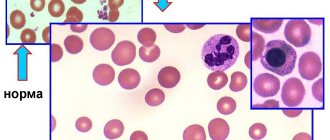Content:
- What is a glucometer and how it works?
- How to properly set up a glucometer?
- How to use a glucometer correctly?
- Short description
Any disorders of carbohydrate metabolism, including diabetes mellitus type 1 or 2, require monitoring of blood glucose levels. For this purpose, a glucometer is used. How to use the strips and the device itself, and calibrate it to obtain reliable results is indicated in the instructions. In general, most devices have similarities in the principle of glucose determination and use.
Hemoglobin test
- supply oxygen to body tissues;
- maintain acid-base balance;
- regulate metabolic rate.
Hemoglobin carries out gas exchange, supplying cells with oxygen and removing carbon dioxide from the lungs. Hemoglobin deficiency leads to a slowdown in metabolic processes, deterioration of brain and heart function, and weakened immunity.
Types of hemoglobin
Blood protein has 6 varieties, each with different properties and importance for human health. Among them:
- Oxyhemoglobin. The protein compound is bright scarlet in color. Responsible for binding oxygen molecules. It forms the basis of arterial blood cells.
- Glycated hemoglobin. A protein-carbohydrate compound that ensures the absorption of glucose. Serves as the main material for testing for diabetes mellitus.
- Carboxyhemoglobin. Associated with carbon molecules Regulates the excretion of carbon dioxide.
- Fetal hemoglobin. Present in the body of the intrauterine fetus and newborn child. As it grows, it turns into other types of hemoglobin. In adults it makes up 1% of the total blood protein. An increase in the level of fetal hemoglobin indicates the development of blood diseases or oncology.
- Methemoglobin. An abnormal type of hemoglobin that does not participate in gas exchange. An increase in methemoglobin volume causes oxygen starvation and death. Serves as a sign of intoxication of the body.
- Myoglobin. Protein related to hemoglobin. Part of the heart muscle and other muscle tissues. The gas exchange function is supported when oxygen levels drop.
During the analysis, each type of hemoglobin is examined. For a number of diseases, the volume of specific types of blood protein is measured.
Who is prescribed a hemoglobin test?
Chronic fatigue, decreased tone, and frequent headaches are good reasons to get tested. The study is also included in any preventive medical examination and medical examination. It helps to quickly identify disturbances in the functioning of the body.
It is recommended to check your hemoglobin level if sleep and appetite worsen, constant pallor, or vision or memory deterioration. In addition, doctors prescribe tests if the following diseases are suspected:
- diabetes;
- anemia;
- cardiovascular diseases;
- dystrophy.
Analysis is required before and after surgery, during pregnancy monitoring, and after large blood losses.
The study is carried out using a Sali hemometer, hemoglobin cyanide analysis or hemichrome method.
What is a glucometer and how it works?
A glucometer is a device that is used to determine the level of glucose in the blood. All modern instruments carry out measurements based on 3 operating principles:
- Photometry
– the concentration of glucose is determined by the strength of the color change of the reagent after contact with blood.
- Biosensory measurement
– blood is applied to the strip, glucose reacts with a certain compound, which leads to a change in the electrical potential, which is recorded by the device.
- Electrochemical determination (coulometry)
– analysis of glucose concentration is carried out by calculating the total charge of electrons after the blood reacts with certain compounds.
To obtain a reliable result, it is important to use the glucometer correctly. The instructions for use contain all the information about the stages of determining blood glucose, as well as calibrating the device.
How to properly set up a glucometer?
Each device must be configured correctly before first use. In almost all glucometers, regardless of the operating principle and manufacturer, the basic settings include the following parameters:
- date and time
.
- OSD language.
- Sugar units
(in most cases the measurement is set in units of mmol/l).
- measurement range
with setting the limit lower and upper sugar concentrations, which are set individually for each person - if during the measurement the device determines that the glucose concentration is above or below the set limit levels, it gives a sound signal and then displays the indicator on the display.
- Instrument calibration
– most models include a special calibration liquid with a certain sugar level. It is applied to the test strip, after which the result on the display is checked with the value given in the operating instructions for the glucometer.
Correct setup before using the meter makes it possible to obtain reliable measurement results in the future.
How to use a glucometer correctly?
The algorithm of actions that determines how to properly use the glucometer depends on the model of the device. For most representatives, the application features are similar:
- To increase blood flow to the fingers, shake the hand.
- Wash the brushes thoroughly, treat the finger with an antiseptic solution (70% alcohol solution).
- The test strip is inserted into a special hole on the device until it stops (usually a characteristic click is heard).
- The finger is pierced with a special scarifier or an automatic piercing pen.
- A drop of blood is applied to the test strip.
- Wait for the result to appear on the display (depending on the glucometer model, you should wait from 5 to 40 seconds).
- Remove the used test strip and discard it.
The nuances and differences regarding how to use a glucometer are indicated in the instructions for each specific model.
It is better to consult with your doctor about the best range of acceptable sugar values. Some instructions on how to properly use the meter have a video on the disc. This is convenient because after viewing, the risk of errors becomes minimal.
Brief instructions for using the glucometer
- Before using it, you need to set the basic settings (date and time, device language, units of measurement).
- Then you need to specify the measurement range (lower and upper values of sugar concentration) and carry out the initial calibration of the glucometer (with calibration liquid).
- each device has its own rules and instructions, but general provisions must be followed, such as hand hygiene, they must be clean, the finger is punctured with a special scarifier, the test strip is inserted into the device until it stops (after use it must be disposed of), the results of using the glucometer occur in range from 5 to 40 seconds.
Symptoms and causes of low hemoglobin
Insufficient hemoglobin content in the blood provokes frequent fatigue, malaise, drowsiness, loss of strength, and bad mood. Patients also complain of constant headache and dizziness. In addition, there is pallor of the skin, poor appetite, tinnitus, cold hands and feet, perversion of taste, pain in the muscles, and the frequent development of colds and viral infections.
In severe cases, the person may lose consciousness. Therefore, in this case, you should definitely visit a doctor and undergo the necessary tests.
Nothing happens for nothing. Including hemoglobin, it cannot decrease without reason. This deficiency in the body is indicated by serious diseases and certain conditions:
- Iron deficiency anemia in chronic form.
- Various bleeding.
- Long-term gastritis.
- Inflammatory bowel pathologies, dysbiosis.
- Time period after surgery.
- Oncology of blood cells.
- Neoplasms in the digestive tract.
- Hepatitis.
- Tuberculosis, pneumonia.
- Iron deficiency.
- Vitamin B12 and folic acid deficiency.
- Destruction of the structure of red blood cells due to severe pathologies.
- Following a diet that involves limiting a large amount of food.
The reasons for a decrease in hemoglobin can be various conditions. However, the greatest impact on protein deficiency is exerted by various blood losses due to surgery, trauma, wounds, and hemorrhoids.
In females, a decrease in hemoglobin most often occurs during menstruation, which lasts more than 5 days.
Blood clotting
Many people begin to fear blood clots after, when donating blood from a vein, the nurse reports that it is too viscous. Those who have too thin blood that successfully fills the test tube hope that they are protected from thrombosis. But viscosity and coagulability are two completely different concepts, and one does not always determine the other.
How viscous you are
Increased blood viscosity, due to which it becomes less fluid, most often occurs due to the predominance of its formed elements over liquid ones. This happens due to too strict adherence to the recommendations “do not eat 12 hours before taking the test” and because of the decision to add one more restriction to this – not to drink. Just to be sure. The end result is worse - and the blood flows poorly into the test tube, and some indicators (for example, hemoglobin, hematocrit, total number of red blood cells, white blood cells and platelets) turn out to be artificially high. Therefore, it is important to remember: before taking blood tests, you should not limit yourself to fluids.
Another common cause of increased viscosity is increased levels of red blood cells and hemoglobin, characteristic of smokers. After all, the more smoke and less air a person inhales, the greater the concentration of oxygen carriers required. Their compensatory increase is formed. Therefore, visually, the blood of smokers often appears more viscous.
According to hematologists, true diseases (thrombocytosis, erythrocytosis, etc.) associated with increased blood viscosity account for a small number of all cases of “viscous blood”. And this is clearly visible from a routine general blood test - the doctor will immediately notice that the number of red blood cells or platelets is too high.
Normally, the content of red blood cells is 3.7-5.1, platelets - 180-320.
Viscosity and coagulability - what's the difference?
The most important indicator is blood clotting. Unfortunately, it can be difficult to obtain accurate information about coagulation, even despite the level of development of medicine. On the one hand, obvious diseases with clotting disorders, such as hemophilia, have long been known. On the other hand, there is a lot of hidden pathology, which may not show itself for a long time, but once manifested, it can quickly lead to serious consequences.
Only in recent decades have researchers learned to identify these problems using high-tech genetic tests. Considering that, according to statistics, more than 1-3% of the world's population has a congenital pathology of the blood coagulation system, it is likely that in the future these tests will be carried out in the maternity hospital for every newborn. And absolutely for those who need to be prescribed certain medications that can increase the risk of blood clots.
Protection or danger?
For example, this is very important to do before prescribing hormonal contraceptives. Their ability to enhance blood clotting and occasionally lead to thrombosis (as it turns out, this almost always occurs in women who have a hidden clotting disorder) has been known for several decades. Due to the widespread use of this method of protection against unwanted pregnancy these days, the incidence of thrombosis in young, apparently healthy women has increased. At the same time, when prescribing COCs, gynecologists rarely focus their patients’ attention on this danger. They can be understood - the complication is infrequent in general, and I don’t want to once again intimidate patients, as if pushing them into an unwanted pregnancy. Meanwhile, the most advanced Western colleagues have already included a full blood clotting test in the mandatory examination algorithm before prescribing hormonal contraceptives.
What will the analysis show?
What tests need to be done to check blood clotting? The most common and familiar analysis to many, a coagulogram, may not answer all questions, especially in the prevention of thrombosis.
However, a classic coagulogram is the first stage of a screening examination of the coagulation system. If it reveals abnormalities, the next step will be more detailed studies of hemostasis - thromboelastography or thromboelastometry. A separate story is the determination of D-dimer , Leiden mutation and other genetic clotting disorders - tests that reveal a tendency to form blood clots in the future. What is necessary and in what cases?
The most common standard coagulogram today includes five components: PTI (prothrombin index); INR (International Normalized Ratio. Reflects the ratio of the patient’s blood clotting time to the blood clotting time of a healthy patient; APTT (activated partial thromboplastin time. Estimates the time it takes for a blood clot to form after special reagents are added to the plasma), FIBROGEN and PLATELET LEVEL.
At the same time, APTT is informative only in people undergoing treatment with heparin, and INR is important only for people constantly taking blood-thinning drugs from the neodicoumarin group (warfarin).
It turns out that two out of five indicators are not so important for screening. The total number of platelets is also not always indicative, because with most coagulopathies it is not their number that changes, but primarily the functional activity.
Therefore, the most informative method, which allows one to evaluate several stages of blood coagulation at once, is thromboelastography. This is a kind of detailed observation of the formation of a blood clot, and its subsequent dissolution (lysis) with the construction of graphs of each of the stages. Thromboelastometry is another version of this study, which is considered even more informative. Unfortunately, the instruments for conducting these studies are expensive and require special training of personnel, so not every laboratory can offer thromboelastography services.
Another important indicator is D-DIMER (this is a breakdown product of fibrin, a small fragment of protein present in the blood after the destruction of a blood clot).
It is actively used to determine the risk of blood clots. Those with even slightly elevated D-dimer are at much greater risk of developing blood clots than others. It is necessary to monitor D-dimer in case of venous diseases (thrombophlebitis), after surgical interventions and upon discharge from the hospital if you have been bedridden for a long time. Monitoring D-dimer levels is useful during pregnancy and when taking hormonal contraceptives (the risk of blood clots in the presence of the Leiden mutation while taking birth control pills increases almost 9 times). And now during COVID-19 and several weeks after recovery.
Today, in addition to D-dimer testing, genetic tests for congenital bleeding disorders are emerging. The most common of these is the Leiden mutation, which occurs in 2–6% of Europeans. The presence of a defective gene increases the likelihood of venous blood clots 6–8 times, and the risk of heart attack and stroke increases significantly. But other mutations, of which there are more than ten today, are no less dangerous. At the same time, timely prevention of thrombosis (mainly the constant use of anticoagulants, the exclusion of certain foods and medications, wearing compression stockings when flying and working on your feet, etc.) reduces the risk of dangerous complications tenfold.
Flickering problem
If everything is in order with the coagulation system, a possible cause of increased coagulation may be arrhythmia, namely atrial fibrillation. According to statistics, 2% of the planet's population suffers from paroxysmal (occurring in attacks) or permanent form of atrial fibrillation. This problem usually appears after thirty. The basis for the disorder is the appearance of pathological turbulence of the electrical impulse in the atria, which gives the myocardium extraordinary electrical stimuli. In medical language, this is called the “re-entry” or re-entry mechanism. As a result, the atria become a churn that churns blood into clots like milk into butter. The situation worsens even more in the case where the person initially had the same clotting disorders. Blood clots can form within 48 hours after the onset of an attack and “fly away” into the arteries of the brain, causing an ischemic stroke, into the intestines, leading to mesenteric thrombosis, into the arteries of the extremities, provoking their acute ischemia.
Von Willebrand factor and COVID -19.
Severe COVID-19 may be associated with elevated levels of one of the blood coagulation factors, von Willebrand factor. Anna Aksenova, a senior researcher at the Laboratory of Amyloid Biology at St. Petersburg State University . Her scientific article was published in the journal Ecological Genetics. It has already been proven that the SARS-Cov-2 virus can have a direct damaging effect on the inner wall of blood vessels. In response to damage, the body strives to “patch” the hole as quickly as possible, and the leading role in this is played by the von Willebrand factor, which is involved in the activation of platelets and, in fact, triggers the process of local thrombus formation. In the course of research, it turned out that some people are characterized by an increased concentration of this factor in their cells, so, as a rule, it is higher in people with blood group II. An individual characteristic of the body is also possible. As a result, in response to massive microdamage to blood vessels, massive microthrombosis occurs, which causes the appearance of larger and more dangerous blood clots.
Genetic mutations of the coagulation system identified during tests:
MUTATION OF COAGULATION FACTOR V OF BLOOD CLOTTING (LEIDEN FACTOR)
PLASMINOGEN ACTIVATOR INHIBITOR 1
MUTATION OF COAGULATION FACTOR II (MUTATION OF PROTHROMBIN)
MUTATION OF METHYLENETETRAHYDROPOLATE REDUCTASE (MTHFR C677T)
MUTATION OF COAGULATION FACTOR VII OF BLOOD CLOTTING (F7 ARG353GLN)
POLYMORPHISM OF THE METHIONINE SYNTHASE REDUCTASE GENE (MTRR A66G)
FIBRINOGEN MUTATION, BETA (FGB G-455A)
MUTATION OF THE PROMOTER OF THE COAGULATION FACTOR GENE FVII (-312 INS 10BP)
INSERTATION/DELETION OF ALU ELEMENT IN THE ANGIOTENSIN CONVERTING ENZYME GENE (ALU INS/DEL)
PLATELET GLYCOPROTEIN 1B ALPHA SUBUNIT MUTATION
PLATELET ADP RECEPTOR MUTATION (P2RY12 H1/H2)
MUTATION A1298C OF METHYLENETETRAFOLATE REDUCTASE GENE
D-dimer is significantly elevated in most patients with moderate to severe COVID-19. Therefore, all patients receive therapeutic doses of anticoagulants.
The Leiden mutation is the most common hidden bleeding disorder, occurring in 2-6% of Europeans.
Published: January 19, 2021







